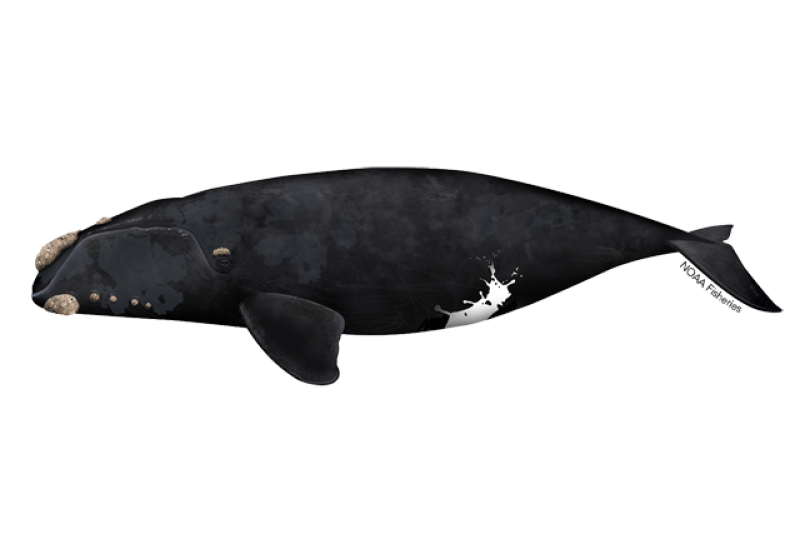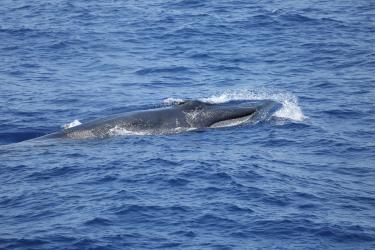Rice's Whale
Rice's Whale
Balaenoptera ricei
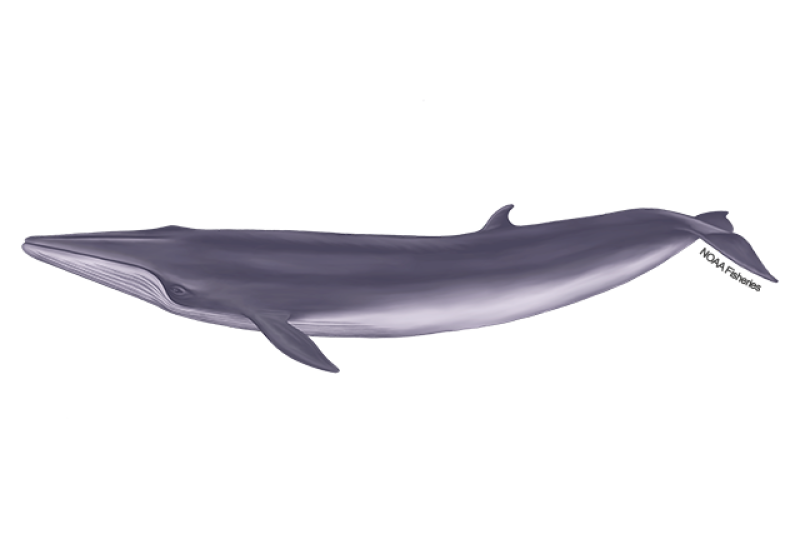
Protected Status
Quick Facts

About the Species

Rice's whales are members of the baleen whale family Balaenopteridae. With likely fewer than 100 individuals remaining, Rice's whales are one of the rarest whales in the world.
Research indicates Rice’s whales are resident and live year-round in the Gulf of America (formerly Gulf of Mexico). They are the only species of baleen whale that regularly occurs in the Gulf. Most sightings of Rice’s whales have been concentrated in 100–400 meter water depths in the northeastern Gulf of America and the west coast of Florida. Sightings have been documented less frequently in the western Gulf, offshore of Louisiana and Texas. Underwater sound recorders along the Gulf continental shelf break from Florida to Texas have detected Rice’s whale calls. Recently calls were detected in Mexican waters, which is the first confirmation that the species also occurs in the southern Gulf.
Rice’s whales are most closely related to Bryde’s (pronounced “broodus”) whales. In 2021, scientists determined that the Rice’s whale is a unique species. They are genetically and morphologically distinct from Bryde’s whales. This determination was supported by studying a whale that stranded dead in the Florida Everglades. The Marine Mammal Stranding Network ensured scientists were able to secure the carcass and study it thoroughly. The species was named Rice’s whale (Balaenoptera ricei) in honor of Dale W. Rice, the first scientist to write about these whales in 1965.

How a unique population of Bryde’s whales became the Rice’s whale
Population Status
In 2019, NOAA Fisheries listed the Gulf of Mexico Bryde’s whale as an endangered subspecies under the Endangered Species Act (ESA). In 2021, NOAA Fisheries revised the common and scientific name of the listed entity to Rice’s whale, Balaenoptera ricei. We revised the classification level from “subspecies” to “species” to reflect the new scientifically accepted taxonomy and nomenclature of the species. Like all marine mammals, the Rice’s whale is also protected under the Marine Mammal Protection Act, where it is listed as depleted.
When NOAA Fisheries scientists completed the comprehensive ESA status review in 2016, they concluded there were likely fewer than 100 individual Rice's whales throughout the Gulf. Our most recent abundance estimate from 2017–2018 surveys in the northeastern Gulf of America indicates there are approximately 50 individual Rice's whales. Additional sighting data were collected during surveys in 2023 and 2024, which will be used to generate an updated population estimate.
Appearance
Rice's whales, like Bryde’s whales, are smaller than sei whales. Bryde’s and Rice’s whales have three prominent ridges in front of their blowhole, though this feature can be difficult to observe at sea. Their body is sleek, and their pectoral fins are slender and pointed. Rice's whales are uniformly dark gray on top with a pale to pink belly. The head of a Rice's whale makes up about one quarter of its entire body length. The whale has a broad fluke, or tail, and a pointed and strongly hooked dorsal fin located about two-thirds of the way back on its body.
Like other baleen whales, Rice’s whales engulf large amounts of water and strain it through baleen plates that hang inside their mouths to catch their prey. They have throat grooves that expand while feeding to increase the amount of seawater—and therefore prey—that they can engulf.
Behavior and Diet
Relatively little is known about Rice’s whales’ foraging ecology and diet. Limited data from two tagged individuals suggest they spend the daytime diving near the floor to feed. At night, they spend the majority of their time within 50 feet of the water's surface, placing them at greater risk of vessel strikes. Available data also suggest they preferentially feed on high-energy-content schooling fish, such as the silver-rag driftfish. This diet is in contrast to Bryde's whales observed feeding in the water column and near the surface on small crustaceans and schooling fish such as anchovy, sardine, mackerel, and herring.
Baleen whales typically produce a variety of highly stereotyped, low-frequency tonal and broadband calls for communication purposes. NOAA Fisheries scientists have characterized the specific call types Rice’s whales produce. With this knowledge, the team uses special underwater sound recording instruments to learn more about where these whales go and when.
Where They Live
Rice’s whales are year-round residents in the Gulf of America. Most sightings and acoustic detections have been concentrated in the northeastern Gulf off the west coast of Florida, but Rice’s whales are also seen and heard in the western Gulf offshore of Louisiana and Texas. Areas of predicted habitat exist in the southern Gulf, along the shelf break of Mexico, and in 2024 researchers published their findings detecting them with acoustic instruments in Mexico waters. Records of “finback whales” from whaling logbooks in the 18th and 19th centuries suggest Rice’s whales may have been more widely distributed throughout the Gulf historically. Rice's whales have stranded along the U.S. Atlantic coast, but no sightings or calls of Rice's whales have been confirmed outside of the Gulf of America.

Lifespan & Reproduction
Based on information from closely-related Bryde’s whales, Rice's whales are likely able to reproduce every 2 to 3 years, reach sexual maturity at age nine, and mate year-round. Based on data from closely related Bryde’s whales, Rice’s whales may be pregnant for 10 to 12 months, and calves may nurse up to 12 months.
Threats
The Rice’s whale’s low genetic diversity, small population size, and restricted range increase its vulnerability to threats. Threats to Rice’s whales from human activities include:
- Vessel strikes
- Noise from vessels and energy exploration
- Oil spills and other pollutants, including lingering effects of the Deepwater Horizon oil spill
- Ingestion of and entanglement in marine debris
- Climate change, including its effect on prey
- Entanglement in fishing gear
For Rice's whales to recover, we must address existing and emerging threats to the species and their habitat.
Vessel Strikes
Vessel strikes can injure or kill Rice's whales. There is a high amount of vessel traffic in the northern Gulf of America, where several commercial shipping lanes coincide with Rice’s whale habitat. In 2009, a female Rice's whale was found dead in Tampa Bay. A necropsy determined that a vessel strike was the cause of death for the animal. NOAA Fisheries scientists are studying photos of living whales to evaluate evidence of non-lethal vessel strike.
Limited tagging data suggest Rice’s whales spend most of their time near the surface at night when it is difficult to see them. The whales’ proximity to the surface during this time of limited visibility increases the chances vessels will strike them.
Ocean Noise
Many human activities in the Gulf of America produce underwater noise. Shipping traffic and energy exploration and development activities, such as the use of seismic airguns, create broadband noise. This noise overlaps with the hearing and call frequency range of Rice’s whales. It is likely that Rice's whales rely on their hearing to perform critical life functions such as communicating, navigating, finding mates and food, and avoiding predators. As ocean noise levels increase, the resulting habitat degradation and disruption to these life functions could result in adverse physical and behavioral effects to Rice's whales.
Rice’s whale habitat in the north-central and western Gulf of America is highly industrialized due to activities and infrastructure associated with energy exploration and production, such as:
- Seismic surveys
- Drilling rigs
- Platforms
- Cables
- Pipelines
- Support vessels
These activities introduce significant amounts of noise into the ocean environment. They also increase the risk of vessel strike from support vessels.
Oil Spills and Other Pollutants
Oil spills are a common occurrence in the Gulf of America. Exposure to oil spills may cause severe illness or death of marine mammals. Oil can coat the baleen that the Rice's whales use to eat. This makes it difficult for them to feed and can cause them to swallow oil. Exposure to oil spills can also lead to:
- Lung and respiratory issues (through inhalation)
- Increased vulnerability to other diseases and infections (through ingestion)
- Irritation of the skin or sensitive tissue in the whale’s eyes and mouths (through absorption)
- Reproductive impacts
Chemicals used to respond to oil spills, called dispersants, may also be toxic to Rice’s whales. Whales continue to face threats from continued exposure to oil and dispersants in the environment long after the oil spill and spill response is considered over. Additionally, their prey is often killed or contaminated by the spill.
The species was likely heavily impacted by the Deepwater Horizon oil spill. Scientists estimate that 48 percent of Rice’s whale habitat in the eastern Gulf was exposed to oil from the spill. As a result, the population may have declined by up to 22 percent, and there are likely lingering effects on reproduction and population growth.
Marine Debris
Rice's whales are also at risk from marine debris. For example, in 2019, a male Rice's whale stranded in the Florida Everglades with a hard piece of plastic in its stomach. The plastic likely contributed to its death. Plastic often ends up in the stomachs of marine wildlife, though it is often difficult to determine if it was indeed the cause of death for stranded animals. Marine debris can also pose an entanglement risk.
Climate Change
Climate change may disproportionately affect species with specialized or restricted habitat requirements. Recent research indicates that Rice’s whales feed selectively on schools of high energy preyfish that occur within a narrow band of habitat along the Gulf of America slope and shelf break. If climate change affects the distribution, abundance, or availability of prey resources, it could have population-level consequences for Rice’s whales.
Entanglement in Fishing Gear
Like all large whale species, Rice’s whales can become entangled in fishing gear, which can cause serious injuries and even death. Historically, two Rice's whales that stranded were entangled in fishing gear. Since 2003, there have been no known serious injuries or mortalities of Rice's whales from interactions with fisheries. However, their primary habitat overlaps with several commercial fisheries; their foraging behavior may place them at risk of becoming entangled in certain types of gear.
NOAA’s Aquaculture Program is working to identify Aquaculture Opportunity Areas in the Gulf of America. This marine spatial planning process identifies areas that are environmentally, socially, and economically sustainable for commercial aquaculture. Rice’s whales and the habitats they depend on— and other endangered species—are being factored in this process to minimize potential impacts. Entanglement of whales at aquaculture farms is rare, with fewer than 20 whale mortalities reported globally due to aquaculture interactions. However, as with recreational and commercial fishing, shipping, or any industrial ocean use, aquaculture uses vessels—contributing to noise pollution and increased risk of vessel strikes.
Natural Threats
The Rice's whale’s very small population size and restricted range increase its vulnerability to natural threats such as disease and inbreeding (which can lower survival and fertility). These natural factors also further reduce the species’ resilience to human threats and catastrophic events, such as oil spills.
Scientific Classification
| Kingdom | Animalia | Phylum | Chordata | Class | Mammalia | Order | Cetartiodactyla | Family | Balaenopteridae | Genus | Balaenoptera | Species | Ricei |
|---|
Last updated by NOAA Fisheries on 06/23/2025
What We Do
Conservation & Management
Our work to protect and recovery these whales includes:
- Developing recovery plan
- Reducing vessel strikes
- Addressing ocean noise
- Overseeing Marine Mammal Health and Stranding Response
- Marine Mammal Unusual Mortality Events
Science
NOAA Fisheries continually conducts research to learn more about the biology, behavior, and ecology of Rice's whales to better inform management and policy decisions. Our work includes:
- Monitoring population abundance and distribution
- Stock assessments
- Investigating prey type, distribution, and energetics
- Identifying habitat requirements
- Investigating dive behavior and energy budgets
- Studying acoustics
- Assessing health
How You Can Help
Reduce Speed and Be on the Lookout
Vessel collisions are a major cause of injury and death for whales. Here are some tips to avoid collisions:
Be Whale Aware. Know where whales occur (habitat).
Watch your speed in areas of known marine mammal occurrence. Keep speeds to 10 knots or less to reduce potential for injury.
Keep a sharp lookout. Look for blows, dorsal fins, tail flukes, etc. However, be aware that most captains report never seeing a whale prior to colliding with it.
Protect your boat, protect your passengers. Boats can be heavily damaged and even "totalled" after colliding with a large whale. Collisions can also injure passengers.
Keep your distance. Stay at least 100 yards away.
Stop immediately if within 100 yards. Slowly distance your vessel from the whale.
Report Marine Life in Distress
Report a sick, injured, entangled, stranded, or dead animal to make sure professional responders and scientists know about it and can take appropriate action. Numerous organizations around the country are trained and ready to respond. Never approach or try to save an injured or entangled animal yourself—it can be dangerous to both the animal and you.
Learn who you should contact when you encounter a stranded or injured marine animal
Keep Your Distance
Be responsible when viewing marine life in the wild. Observe all large whales from a safe distance of at least 100 yards and limit your time spent observing to 30 minutes or less.
Report a Violation
Call the NOAA Fisheries Enforcement Hotline at (800) 853-1964 to report a federal marine resource violation. This hotline is available 24 hours a day, 7 days a week for anyone in the United States.
You may also contact your closest NOAA Office of Law Enforcement field office during regular business hours.
Featured News
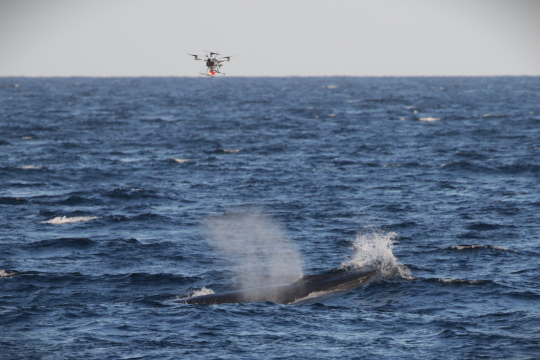 A drone hovers over a Rice’s whale, ready to drop a suction cup tag to collect data. Credit: NOAA Fisheries/Ocean Alliance (Permit #21938)
A drone hovers over a Rice’s whale, ready to drop a suction cup tag to collect data. Credit: NOAA Fisheries/Ocean Alliance (Permit #21938)
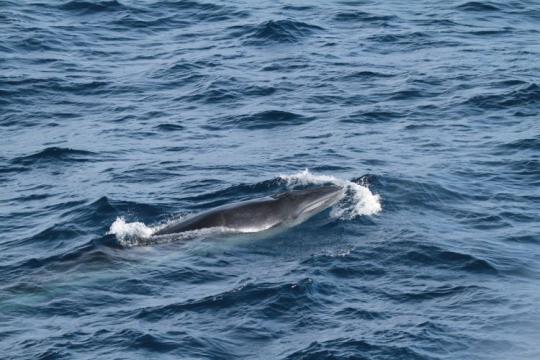 A Rice’s whale in the Gulf of Mexico. Permit #14450. Credit: NOAA Fisheries/Laura Dias
A Rice’s whale in the Gulf of Mexico. Permit #14450. Credit: NOAA Fisheries/Laura Dias
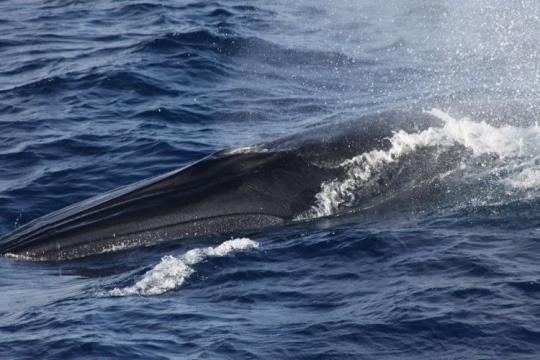 Three ridges on the rostrum (dorsal head) of this Rice’s whale. Credit: NOAA Fisheries/Laura Dias (Permit #14450)
Three ridges on the rostrum (dorsal head) of this Rice’s whale. Credit: NOAA Fisheries/Laura Dias (Permit #14450)
In the Spotlight
Rice’s Whale
The Rice’s whale is NOAA Fisheries’ newest Species in the Spotlight. This initiative is a concerted, agency-wide effort launched in 2015 to bring greater attention and marshal resources to save these highly at-risk species.

Scientists have known that these medium-sized baleen whales occur in the Gulf of America (formerly Gulf of Mexico) for decades. For most of that time, the whales were believed to be a subpopulation of Bryde’s whale, which occur in other temperate and tropical waters around the globe. After years of research, a team of scientists demonstrated in 2021 that Rice’s whales are genetically and morphologically distinct from Bryde’s whales. Rice’s whale is in fact a unique whale species that is only known to reside in the Gulf of America. The species was named in honor of Dale W. Rice, the first scientist to write about the whales in 1965.
Rice's whales grow to longer than 40 feet and weigh up to 30 tons. Like Bryde’s whales, Rice’s whales have three parallel ridges on top of their head. This feature distinguishes them from sei, fin, and minke whales, which have a single rostral ridge. They are uniformly gray on top, with a pale to pink belly, and have a strongly hooked dorsal fin. Acoustic research has shown that Rice’s whales communicate using unique vocalizations, or calls, which can be detected with passive acoustic monitoring devices.
NOAA Fisheries listed the Rice’s whale (then known as the Gulf of Mexico Bryde’s whale) as an endangered species under the Endangered Species Act in 2019. Rice’s whales are also protected under the Marine Mammal Protection Act and are considered depleted. The species’ small population size and high extinction risk make it a priority for NOAA Fisheries and our partners to recover.
Where Rice’s Whales Live
Rice’s whales are only known to reside in the Gulf of America, where they live year-round. Most sightings have been concentrated in the northeastern Gulf off the West Coast of Florida. They have also been seen and heard in the western Gulf offshore of Louisiana and Texas. Areas of predicted habitat exist in the southern Gulf, along the shelf break of Mexico. Rice's whale calls were recently detected offshore of Tampico, but the extent to which the whales inhabit Mexican waters is unknown. Records of “finback whales” from whaling logbooks in the 18th and 19th centuries suggest Rice’s whales may have been more widely distributed throughout the Gulf of America historically. Rice's whales have stranded along the U.S. Atlantic coast, but no sightings or calls of Rice's whales have been confirmed outside of the Gulf of America.
Population Status
The species likely numbers fewer than 100 individuals, making it among the most endangered species of whale in the world. The most recent abundance estimate from 2017–2018 surveys in the eastern Gulf of America is approximately 50 individuals. Rice’s whales are one of the marine mammal species that was most heavily impacted by the Deepwater Horizon oil spill. A modeling study conducted after the spill estimated that 48 percent of Rice’s whale habitat in the eastern Gulf was exposed to oil. The population declined by as much as 22 percent compared to its pre-spill size. Few calves have been seen during surveys since 2010. There have been frequent observations of individual whales in poor body condition, suggesting there may be lingering effects on reproduction and population growth.
Habitat
Most visual sightings and acoustic detections of Rice’s whales have occurred along the Gulf of America shelf break, in waters that are 100–400 meters deep. Recent tagging and foraging studies indicate the whales dive toward the seafloor during daylight hours. They seek out high-energy prey fish, like the silver-rag driftfish, which occur in large schools along the bottom. At night, the whales appear to spend most of their time near the surface, a behavior that could place them at greater risk of vessel strikes.
Threats
The Gulf of America is highly industrialized and impacted by many human activities. These activities can pose risks to Rice’s whales and their habitat through:
- Vessel strikes
- Noise from vessels and energy exploration
- Oil spills and other pollutants, including lingering effects of the Deepwater Horizon oil spill
- Ingestion of and entanglement in marine debris
- Climate change and its effect on prey
- Entanglement in fishing gear
The species’ low genetic diversity, small population size, and restricted range further reduces its resilience to threats.
Examples of Threats
In 2009, an adult female Rice’s whale was struck and killed by a ship. Her body was carried into Tampa Bay draped across the ship’s bow. Researchers determined that she was lactating at the time of her death. If she was nursing a calf, her calf probably also died, during or after the strike. In 2019, NOAA scientists photographed a free-swimming Rice’s whale with a severely deformed spine that was likely caused by a vessel strike. In that same year, an adult male Rice’s whale died after ingesting marine debris and washed ashore in southwest Florida. These three observed deaths represent only a fraction of actual mortalities. It is difficult to effectively monitor deaths of Rice’s whales because the whales live far from shore, and we do not regularly conduct surveys in their known habitat.
Species Recovery
We have made tremendous strides in our understanding of Rice’s whales in a short period of time. Several challenges still complicate Rice’s whale recovery, such as:
- Gaps in our scientific knowledge about Rice’s whale life history, demographics and distribution
- Understanding how existing and emerging human activities impact Rice’s whales and their habitat, and how to reduce those impacts
- Limited awareness about the species amongst the public and regional stakeholders
To begin addressing these challenges NOAA Fisheries released a Rice’s Whale Recovery Outline in 2020. It serves as an interim conservation strategy until a full recovery plan is developed. The recovery outline summarizes the key factors that are known (and unknown) about their:
- Biology
- Population status
- Primary threats
- Conservation actions taken to date
It also establishes an interim recovery strategy and action plan, including actions that are needed for research, outreach, and to manage threats.
In 2021, we hosted a virtual, multi-session Rice’s Whale Recovery Planning Workshop (PDF, 49 pages) to gather information, facts, and perspectives on how to recover Rice’s whales. Participants included federal and state agencies, scientific experts, commercial fishery representatives, conservation partners, and non-governmental organizations. Information gleaned from the workshop is being considered as NOAA Fisheries develops the Rice’s Whale recovery plan. We will also be developing a Species in the Spotlight Priority Action Plan to identify priority activities over the next 5 years, which will complement the recovery planning effort.
Last updated by NOAA Fisheries on 06/23/2025
Management Overview
The Rice's whale is listed as endangered under the Endangered Species Act.
The Rice's whale is protected throughout its range under the Marine Mammal Protection Act.
The Rice's whale is depleted under the Marine Mammal Protection Act.
Additionally, the Rice's whale is listed under:
Recovery Planning and Implementation
Under the ESA, NOAA Fisheries is required to develop and implement recovery plans for the conservation and survival of listed species. We are committed to the protection and recovery of the Rice’s whale, with the ultimate goal of helping this species recover from its very low population size. This would allow the species to be reclassified from endangered to threatened and ultimately be removed from the list of threatened and endangered species.
Recovery Outline
NOAA Fisheries has developed a recovery outline to serve as an interim guidance document to direct recovery efforts, including recovery planning, for the Rice’s whale until a full recovery plan is developed and approved. The recovery outline presents a preliminary strategy for recovery of the species and recommends high priority actions to stabilize and recover the species.
Recovery Planning Workshops
We conducted a series of virtual recovery planning workshop sessions for the Rice’s whale in October and November 2021. The purpose of the workshops was to gather information, facts, and perspectives on how to recover the Rice’s whale, including identifying potential recovery criteria and actions to address the threats to Rice’s whales. Participants included federal and state agencies, scientific experts, commercial fishery representatives, conservation partners, and non-governmental organizations. The sessions covered the following topics:
- October 18, 2021 – Introduction to Recovery Planning, Species and Threats Overview, ESA Section 7 Effects Analysis Overview, Discussion on Session Topic-Related Recovery Actions and Recovery Criteria
- November 1, 2021 – Climate Change and Renewable Energy, Prey, Entanglement and Fisheries Interactions, Threats Rankings, Discussion on Session Topic-Related Recovery Actions and Recovery Criteria
- November 10, 2021 – Environmental Pollutants and Disease/Health Indicators, Marine Debris, Threats Rankings, Discussion on Session Topic-Related Recovery Actions and Recovery Criteria
- November 16, 2021 – Anthropogenic Noise/Acoustic Habitat, Vessel Collisions, Threats Rankings, Discussion on Session Topic-Related Recovery Actions and Recovery Criteria
- November 18, 2021 – Workshop Recap: Threat Rankings, Recovery Criteria Review and Discussion, Next Steps
Recovery planning workshop summary
Recovery planning workshop summary appendices
Critical Habitat
Once a species is listed under the ESA, NOAA Fisheries evaluates and identifies whether any marine areas meet the definition of critical habitat. Those areas may be designated as critical habitat through a rulemaking process. A critical habitat designation does not set up a marine preserve or refuge. Rather, federal agencies that undertake, fund, or permit activities that may affect designated critical habitat areas are required to consult with NOAA Fisheries to ensure that their actions do not adversely modify or destroy these designated critical habitats.
On July 24, 2023, NOAA Fisheries proposed to designate critical habitat for the endangered Rice’s whale.
- Proposed rule; request for comments. The comment period was extended; it closed on October 6, 2023
- Proposed Rice’s whale critical habitat map
- Draft critical habitat report (PDF, 85 pages)
NOAA Fisheries Southeast Regional Office held two virtual public hearings on the proposed rule in August and September 2023.
Conservation Efforts
Reducing Vessel Strikes
Collisions between whales and large vessels can injure or kill the whales and damage the vessels, but they often go unnoticed and unreported. The most effective way to reduce collision risk is to keep whales and vessels apart. When this is not possible, the next best thing is for vessels to slow down and keep a lookout for whales to reduce both the likelihood of collisions as well as the potential severity of impact if one occurs. In all but one instance when captains have self-reported a collision with a North Atlantic right whale, the crew reported they never saw a whale before the collision happened.
Learn more about reducing vessel strikes
Addressing Ocean Noise
Low-frequency underwater noise may threaten Rice’s whales by interrupting their normal behavior and driving them away from areas important to their survival, such as feeding areas. NOAA Fisheries is investigating all aspects of acoustic communication and hearing in marine animals, as well as the effects of sound on whale behavior and hearing. In 2018, we revised technical guidance for assessing the effects of anthropogenic (human-caused) sound on marine mammal hearing.
Overseeing Marine Mammal Health and Stranding Response
We work with volunteer networks in all coastal states to respond to marine mammal strandings including all whales. When stranded animals are found alive, NOAA Fisheries and our partners assess the animal’s health and determine the best course of action. When stranded animals are found dead, our scientists work to understand and investigate the cause of death. Although the cause often remains unknown, scientists can sometimes attribute strandings to disease, harmful algal blooms, vessel strikes, fishing gear entanglements, pollution exposure, and underwater noise. Some strandings can serve as indicators of ocean health, giving insight into larger environmental issues that may also have implications for human health and welfare.
Learn more about the Marine Mammal Health and Stranding Response Program
Marine Mammal Unusual Mortality Events
Rice's whales have been part of a previous unusual mortality event. Under the Marine Mammal Protection Act, an unusual mortality event is defined as "a stranding that is unexpected; involves a significant die-off of any marine mammal population; and demands immediate response." To understand the health of marine mammal populations, scientists study unusual mortality events.
Get information on active and past UMEs
Get an overview of marine mammal UMEs
Educating the Public
NOAA Fisheries aims to increase public awareness and support for Rice's whale conservation through education, outreach, and public participation. We share information with the public about the status of Rice's whales, our research, and efforts to promote their recovery.
Regulatory History
NOAA Fisheries listed the "Gulf of Mexico Bryde’s whale" subspecies in 2019 as endangered under the Endangered Species Act. In 2021, we revised the common and scientific name to Rice’s whale, Balaenoptera ricei, and its classification to species to reflect the scientifically accepted taxonomy and nomenclature of the whales. This change to the species and common names does not affect its ESA listing status.
Key Actions and Documents
Incidental Take Authorization: U.S. Air Force Eglin Gulf Testing and Training
Incidental Take Authorization: Oil and Gas Industry Geophysical Survey Activity in the Gulf of America
- 2025 Notice of Receipt of Application
- 2025 Notice of Receipt for Reimplementation
- 2024 Final Rule
- 2023 Proposed Rule
- 2021 Correction to the Final Rule
Incidental Take Authorization: U.S. Navy Atlantic Fleet Training and Testing (AFTT) along Atlantic and Gulf Coasts (2018-2025)
- Correction to Final 7-Year Rule
- Final 7-Year Rule (2019)
- Proposed 7-Year Rule (2019)
- Notice of Receipt of Application for 7-Year LOA
- Final 5-year Rule (2018)
Incidental Take Authorization: U.S. Navy Atlantic Fleet Training and Testing (2013 -2018)
Last updated by NOAA Fisheries on 06/23/2025
Science Overview
NOAA Fisheries conducts various research activities on the biology, behavior, and ecology of the Rice's whale. The results of this research are used to inform management decisions for this species.
Trophic Interactions and Habitat Requirements of Rice’s Whales
As part of the RESTORE Science Program-funded Gulf of Mexico Rice’s Whale Trophic Ecology Project, we worked with Scripps Institution of Oceanography and Florida International University on a multi-year study to develop a comprehensive ecological understanding of the endangered Rice's whale. In 2018 and 2019, we collected data on the physical, oceanographic, and biological features that may influence Rice’s whale distribution in the Gulf. We surveyed mostly within the species’ current core distribution area using a multifaceted approach to collect data.
More about trophic interactions and habitat requirements of Rice's Whales
Stock Assessments
Information from marine mammal stock assessment reports are used to identify and evaluate the status of marine mammal populations and help to design and conduct appropriate conservation measures. Continuing data collection, analysis, and interpretation of Rice's whales is updated and incorporated into annual stock assessment reports.
Shipboard Studies
In addition to surveys supporting stock assessments, we also conduct research cruises to investigate the whales’ habitat preferences, feeding ecology, and to conduct photographic and genetic identification. This research is used to inform management actions that protect the Rice's whale.
Acoustic Science
Acoustics is the science of how sound is transmitted, and NOAA Fisheries works to understand the basic acoustic behavior of whales, dolphins, and fish; map the acoustic environment; and develop better methods to locate cetaceans
Learn more about acoustic science
More Information
Recent Science Blogs
Last updated by NOAA Fisheries on 06/23/2025
Documents
Meet the Rice's Whale
An infographic about the newly described species and one of the most endangered whales in the world
Recovering Threatened and Endangered Species Report to Congress (FY 2021-2022)
This Report to Congress summarizes efforts to recover all transnational and domestic species under…
Rice's Whale Recovery Outline
This document serves as an interim guidance document to direct recovery efforts for the Rice's…
Biological Opinion on the Federally Regulated Oil and Gas Program Activities in the Gulf of Mexico
Programmatic biological opinion on the Gulf of Mexico oil and Gas Program in federal waters…
Research
A density surface model describing the habitat of the Critically Endangered Rice’s whale Balaenoptera ricei in the Gulf of Mexico
This research characterizes habitat for endangered Rice’s whales based on oceanographic parameters…
Marine Mammal Photo-Identification Research in the Southeast
We use photos to identify, catalog, and study marine mammals in the Southeast. These photos provide important information about the health, social structure, abundance, and distribution of marine mammal populations.
Rice's Whale Occurrence in the Western Gulf of Mexico from Passive Acoustic Recordings
This research summarizes acoustic detections of Rice’s whales in the western Gulf of Mexico,…
Critically Endangered Rice’s Whales (Balaenoptera ricei) Selectively Feed on High-quality Prey in the Gulf of Mexico
Results from this study indicate that Rice’s whales are selective predators consuming schooling…
Outreach & Education
Protected Marine Species Identification Guide Southeast United States
This guide is intended for use by mariners in the identification and reporting of threatened and…
Last updated by NOAA Fisheries on 06/23/2025



